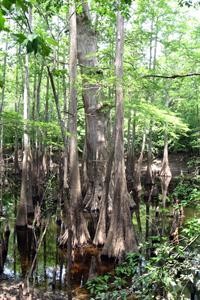New Natural Area Protects Rare Species
Natural areas can be found across Arkansas and they protect the diverse ecosystems that are found in the state. The Longview Saline Natural Area in Ashley County is a new addition to the lineup.

The area borders a stretch of the Saline River that harbors endangered mussels. It also conserves plant communities, including pine flatwoods, that provide habitat for an endangered bird species.
“This particular natural area has several natural communities that are rare in the state,” said Chris Colclasure, Deputy Director of the Arkansas Natural Heritage Commission (ANHC), which manages the System of Natural Areas in the state. “And it supports three federally endangered species.”
These include the Red-cockaded Woodpecker, one of the few bird species endemic to the U.S., and two aquatic mussels found within the stretch of the Saline River that borders the natural area: the winged mapleleaf and pink mucket.
A tiny red line can be found on either side of the head of male red-cockaded woodpeckers. A cockade is a ribbon worn on a hat and this red stripe is the ‘cockade’ of the bird. It may be hidden and is very difficult to see in the field.
“The area conserves a portion of the lower Saline River and has countless other species and natural community types that are rare in the state,” said Colclasure.
“This natural area also serves as a wonderful example of public and private partners coming together and working for our state’s long term ecological success,” added Karen Smith director of ANHC. The Saline River flows southeast from Benton before joining the Ouachita River at Felsenthal National Wildlife Refuge near the Louisiana border. It is one of the most bio-diverse and species-rich river systems in the state. The river is also known for its abundance and diversity of mussels, which have important functions in aquatic environments. They are a link in the food chain and help maintain water quality. Because they are long-lived and sensitive to changes in water quality, they are important indicators of aquatic ecosystem health. The disappearance of mussels from a river often signals that other aquatic species are at risk.
Fox also noted a potential to expand the area in the future. “The possibility exists that it could be a few thousand more acres in 2 or 3 more phases,” he said. “If [certain] negotiations are successful the natural area could grow.”
The project has been a cooperative effort between the Arkansas Natural Heritage Commission (ANHC), the Arkansas Field Office of The Nature Conservancy, Molpus Timberlands Management, LLC, and the Arkansas Game and Fish Commission. For more information on The Longview Saline Natural Area and other natural areas across Arkansas, visit www.naturalheritage.com.